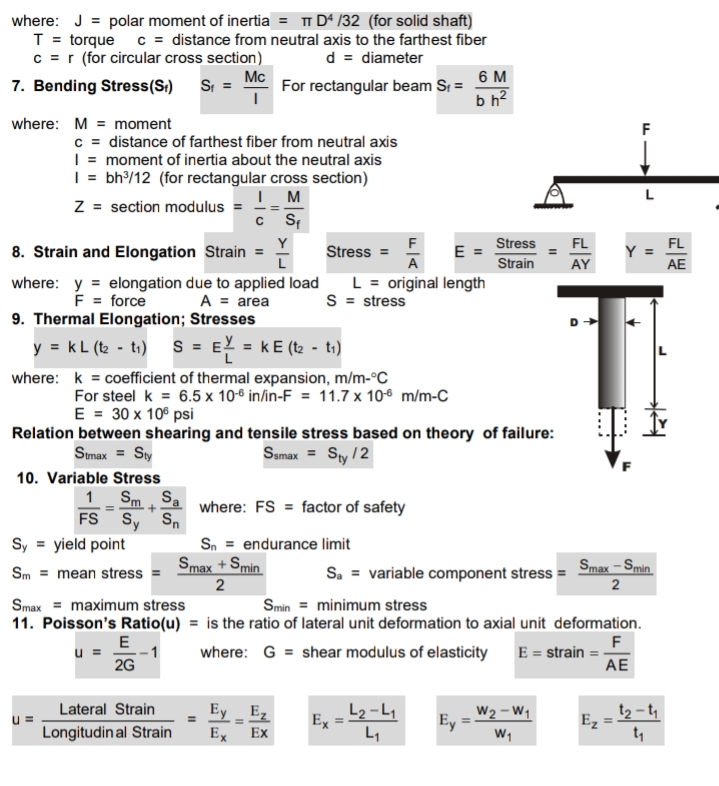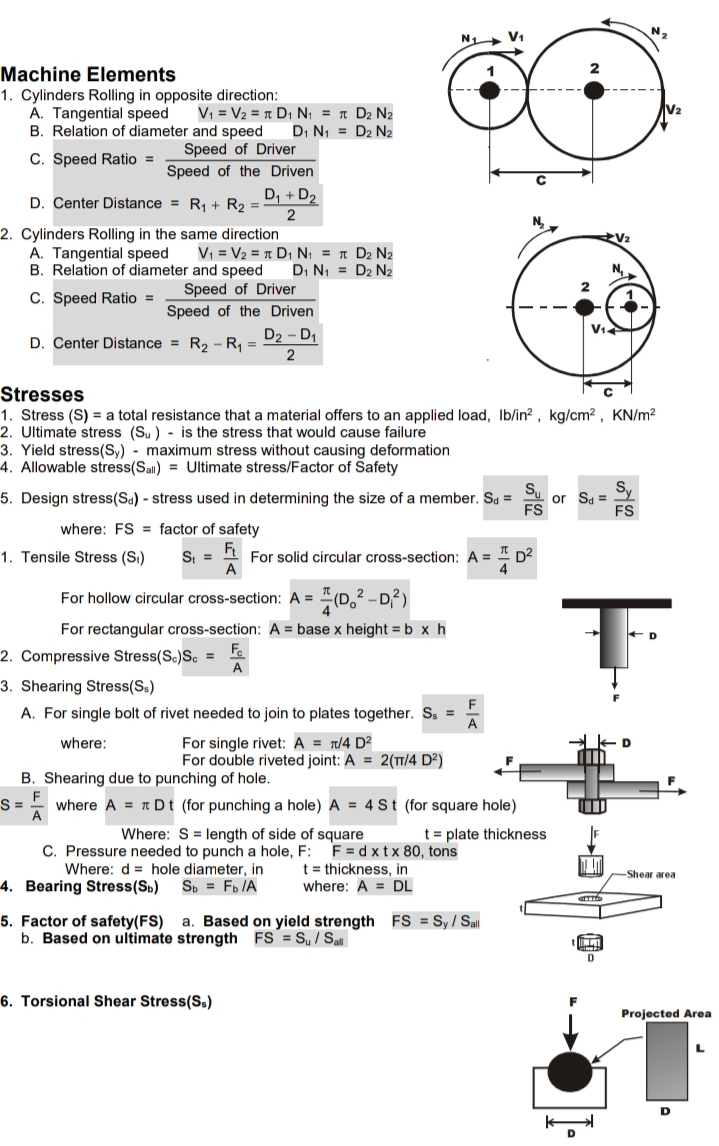A shaft when subjected to pure torsion developed a stress of 50 Mpa. If polar moment of inertia is 6.1359 x 10 -7 m4 , determine the maximum torque the shaft could handle. A. 1.23 KN.m B. 1.68 KN.m C. 1.84 KN.m D. 2.48 KN.m
A shaft when subjected to pure torsion developed a stress of 50 Mpa. If polar moment of inertia is 6.1359 x 10 -7 m4 , determine the maximum torque the shaft could handle. A. 1.23 KN.m B. 1.68 KN.m C. 1.84 KN.m D. 2.48 KN.m
Elements Of Electromagnetics
7th Edition
ISBN:9780190698614
Author:Sadiku, Matthew N. O.
Publisher:Sadiku, Matthew N. O.
ChapterMA: Math Assessment
Section: Chapter Questions
Problem 1.1MA
Related questions
Question
A shaft when subjected to pure torsion developed a stress of 50 Mpa. If polar moment of
inertia is 6.1359 x 10
-7 m4
, determine the maximum torque the shaft could handle.
A. 1.23 KN.m B. 1.68 KN.m C. 1.84 KN.m D. 2.48 KN.m

Transcribed Image Text:where: J = polar moment of inertia = T Dª /32 (for solid shaft)
c = distance from neutral axis to the farthest fiber
T = torque
c = r (for circular cross section)
7. Bending Stress(S:) Si =
d = diameter
For rectangular beam S = 6 M
b h?
Mc
where: M = moment
F
c = distance of farthest fiber from neutral axis
| = moment of inertia about the neutral axis
| = bh/12 (for rectangular cross section)
I M
c Sf
L
Z = section modulus
Y
8. Strain and Elongation Strain =
Stress
FL
Stress =
A
E
Strain
FL
Y =
AE
AY
where: y = elongation due to applied load
L = original length
F = force
A = area
S = stress
9. Thermal Elongation; Stresses
y = kL (t2 - t1) S = E! = kE (t2 - t1)
where: k = coeficient of thermal expansion, m/m-°C
For steel k = 6.5 x 10-6 in/in-F = 11.7 x 106 m/m-C
E = 30 x 10° psi
Relation between shearing and tensile stress based on theory of failure:
Samax = Sty /2
Smax = Sty
10. Variable Stress
1 Sm Sa
FS Sy S,
Sy = yield point
where: FS = factor of safety
Sn = endurance limit
Smax + Smin
S. = variable component stress =
Smax - Smin
Sm = mean stress =
2
2
Smax = maximum stress
11. Poisson's Ratio(u) = is the ratio of lateral unit deformation to axial unit deformation.
Smin = minimum stress
E
F
E = strain =-
AE
where: G = shear modulus of elasticity
2G
W2 – W1
Ey
t2 - ty
Lateral Strain
Ey Ez
Ex
L2 -L,
Ex
L1
Ez
Longitudin al Strain
Ex
t,

Transcribed Image Text:V1
Machine Elements
1. Cylinders Rolling in opposite direction:
Á. Tangential speed
B. Relation of diameter and speed
V, = V2 = T D, N, = r D2 N2
DI N1 = D2 N2
Speed of Driver
C. Speed Ratio =
Speed of the Driven
D. Center Distance = R, + R2 =
D, + D2
2. Cylinders Rolling in the same direction
Vi = V2 = n D, N; = n D2 N2
D, N1 = D2 N2
A. Tangential speed
B. Relation of diameter and speed
Speed of Driver
Speed of the Driven
D2 - D1
C. Speed Ratio =
D. Center Distance = R2 -R, =
Stresses
1. Stress (S) = a total resistance that a material offers to an applied load, Ib/in? , kg/cm² , KN/m?
2. Ultimate stress (Su ) - is the stress that would cause failure
3. Yield stress(Sy) - maximum stress without causing deformation
4. Allowable stress(Sal) = Ultimate stress/Factor of Safety
Sy
5. Design stress(Sa) - stress used in determining the size of a member. Sa =
or Sa =
FS
FS
where: FS = factor of safety
1. Tensile Stress (S.)
S =
For solid circular cross-section: A =
A
D2
#0,² -D²)
For hollow circular cross-section: A =
For rectangular cross-section: A = base x height = b x h
Fa
2. Compressive Stress(Sc)S. =
A
3. Shearing Stress(S.)
F
A. For single bolt of rivet needed to join to plates together. S, =
For single rivet: A = t/4 D²
For double riveted joint: A = 2(TT/4 D²)
where:
D
B. Shearing due to punching of hole.
S =
where A = 1 Dt (for punching a hole) A = 4 St (for square hole)
Where: S = length of side of square
C. Pressure needed to punch a hole, F: F = d x t x 80, tons
t = plate thickness
t = thickness, in
where: A = DL
Where: d = hole diameter, in
-Shear area
4. Bearing Stress(Sb)
Sp = Fb IA
a. Based on yield strength FS = Sy / Sall
5. Factor of safety(FS)
b. Based on ultimate strength FS = S,/ Sall
D
6. Torsional Shear Stress(Ss)
Projected Area
D
Expert Solution
This question has been solved!
Explore an expertly crafted, step-by-step solution for a thorough understanding of key concepts.
This is a popular solution!
Trending now
This is a popular solution!
Step by step
Solved in 2 steps with 2 images

Recommended textbooks for you

Elements Of Electromagnetics
Mechanical Engineering
ISBN:
9780190698614
Author:
Sadiku, Matthew N. O.
Publisher:
Oxford University Press

Mechanics of Materials (10th Edition)
Mechanical Engineering
ISBN:
9780134319650
Author:
Russell C. Hibbeler
Publisher:
PEARSON

Thermodynamics: An Engineering Approach
Mechanical Engineering
ISBN:
9781259822674
Author:
Yunus A. Cengel Dr., Michael A. Boles
Publisher:
McGraw-Hill Education

Elements Of Electromagnetics
Mechanical Engineering
ISBN:
9780190698614
Author:
Sadiku, Matthew N. O.
Publisher:
Oxford University Press

Mechanics of Materials (10th Edition)
Mechanical Engineering
ISBN:
9780134319650
Author:
Russell C. Hibbeler
Publisher:
PEARSON

Thermodynamics: An Engineering Approach
Mechanical Engineering
ISBN:
9781259822674
Author:
Yunus A. Cengel Dr., Michael A. Boles
Publisher:
McGraw-Hill Education

Control Systems Engineering
Mechanical Engineering
ISBN:
9781118170519
Author:
Norman S. Nise
Publisher:
WILEY

Mechanics of Materials (MindTap Course List)
Mechanical Engineering
ISBN:
9781337093347
Author:
Barry J. Goodno, James M. Gere
Publisher:
Cengage Learning

Engineering Mechanics: Statics
Mechanical Engineering
ISBN:
9781118807330
Author:
James L. Meriam, L. G. Kraige, J. N. Bolton
Publisher:
WILEY